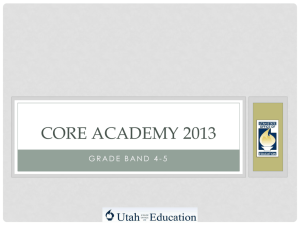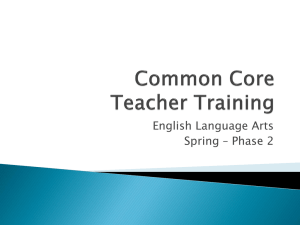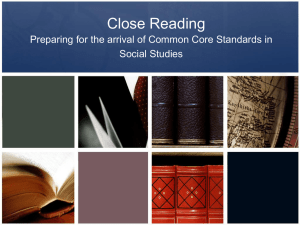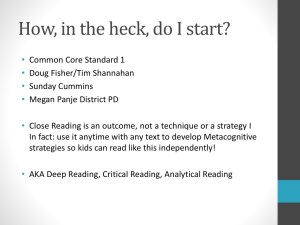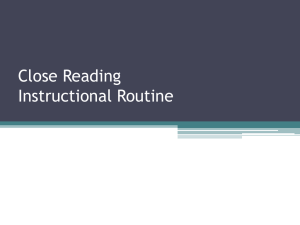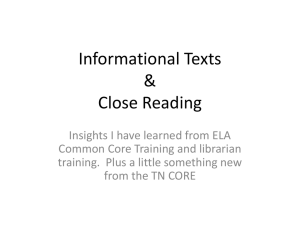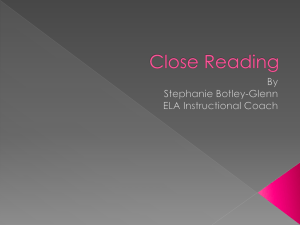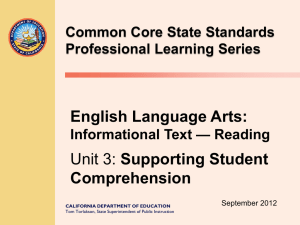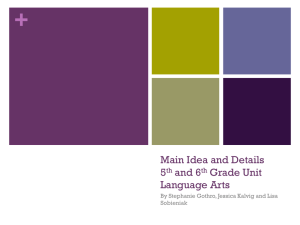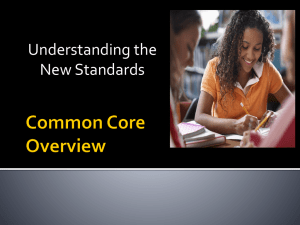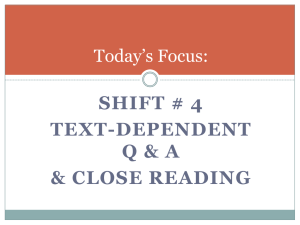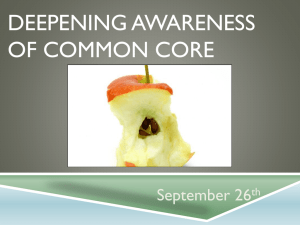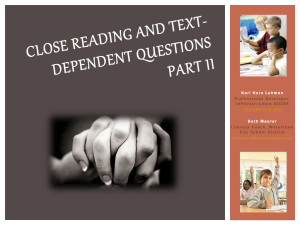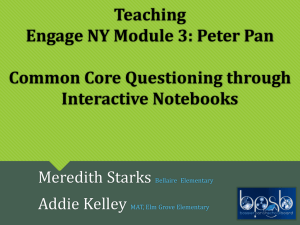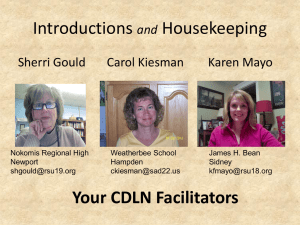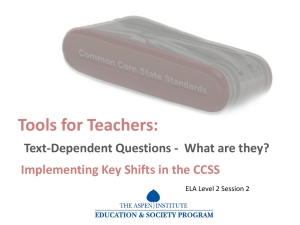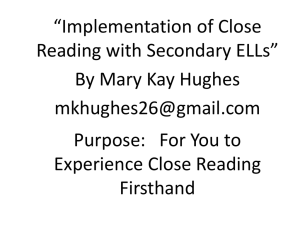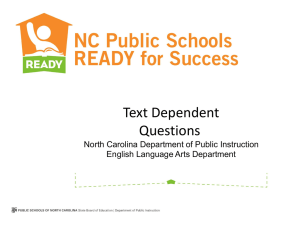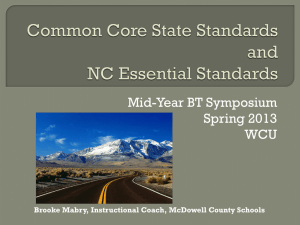PowerPoint Day 1
advertisement
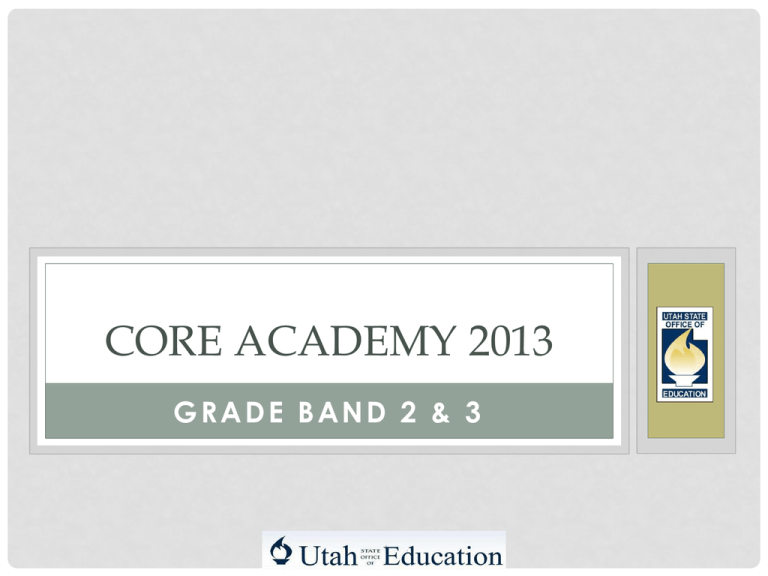
CORE ACADEMY 2013 GRADE BAND 2 & 3 WELCOME! • My name is _____ • I teach at: _____ • I’ve taught for _____ years. • My item is _____, and it represents me because_____. • How many years combined teaching experience is in this room? UTAH CORE STANDARDS THE STANDARDS FOR ENGLISH LANGUAGE ARTS K -5 THE APPENDICES FOR THE STANDARDS STANDARDS BASED ON RESEARCH INSTRUCTIONAL SHIFTS IN THE NEW STANDARDS 1. Building knowledge through content-rich informational text 2. Reading, writing and speaking grounded in evidence from text, both literature and informational text 3. Regular practice with complex text and its academic language THE STRANDS RF RI RL Foundational Skills Reading Informational Text Reading Literature L SL W Language Speaking and Listening Writing LABELING OUR CORE Reading Anchor Standards – pg 12 Reading for Literature RL - pg 13 Reading for Informational Text RI – pg 15 Reading Foundational Skills RF – pg 17 Writing Anchor Standards W – pg 21 Speaking and Listening SL - pg 25 Language Anchor Standards L - 28 LABELING CONTINUED In Appendix A - Articles • • • • • • Text Complexity – pg 3 Foundational Skills – pg 18 Writing Text Types – pg 24 Speaking and Listening – pg 27 Language – pg 29 Vocabulary – pg 33 CLOSE READING WHERE IS THIS IN THE UTAH CORE? Page 12 in key ideas and details number 1 Close reading is not a standard but a practice through which the standards are achieved. WHAT IS CLOSE READING? • Close reading is thoughtful, critical analysis of a text that focuses on significant details or patterns in order to develop a deep, precise understanding of the text’s form, craft, meanings, etc. • It is a key requirement of the Common Core State Standards and directs the reader’s attention to the text itself. baburke@aacrc.net 2013 CLOSE READING • Read Article “Close Reading in Elementary Classrooms” By Fisher & Frey • Underline key words and phrases that are meaningful. • What would a “first read” look like with grade level text in your classroom? • Close Reading Prezi SCAFFOLDING STUDENTS IN CLOSE READING • While the goal for students is to read complex texts independently, not all students will be able to achieve that immediately. • Scaffolding instruction is a model in which the teacher supports students and gradually releases responsibility to the student. SCAFFOLDING CLOSE READING • Shared reading • Interactive read aloud • Comprehension Toolkit lessons • Literature circles • Reciprocal teaching • Graphic Organizers • Jigsaws CLOSE READING INCLUDES: Using short passages and excerpts Diving right into the text with limited pre-reading activities Focusing on the text itself Rereading deliberately Reading with a pencil Noticing things that are confusing Discussing the text with others Think-Pair Share or Turn and Talk frequently Small groups and whole class Responding to text-dependent questions baburke@aacrc.net 2013 STEPS IN CLOSE READING • There is no specific sequence in a close read; these steps are meant to generally guide you in crafting a lesson that scaffolds students and focuses on increasingly complex text dependent questions. • Begin with questions about the big ideas in the text and gradually ask higher level questions. baburke@aacrc.net 2013 FIRST READ: KEY IDEAS AND DETAILS • Set the purpose for reading and have students read text as independently as possible. • Depending on the text complexity and the readers, the first read may be done independently, as a read aloud/think aloud, or paired or shared reading. • The first read should be without building background; students should be integrating their background knowledge with the text as they read. • Focus on the key ideas and details in the text, making sure that readers know the main idea, story elements, or key details that the author includes. • Following the first read, have students Think-Pair-Share to assess what they have gleaned from the text. By listening to students as they share, you can determine the focus of the first read, etc. baburke@aacrc.net 2013 SECOND READ: CRAFT AND STRUCTURE • For a second close read, select a portion or chunk of the text that is “close read worthy.” That is, have students reread a section that includes complex elements or ideas that they should explore to arrive at a deep understanding of the text. • After rereading, students discuss the text with partners or in small groups, focusing on the author’s craft and organizational patterns. This may include vocabulary choices, text structure, or text features that the author included. • Use a Text Dependent Questions to focus or set a purpose for a close rereading. After students share with partners or in small groups, have groups share out with entire class to assess understanding. baburke@aacrc.net 2013 THIRD READ: INTEGRATION OF KNOWLEDGE AND IDEAS • The third close reading of a text should go even deeper, requiring students to synthesize and analyze information from several texts or media. They may record their ideas on sticky notes, graphic organizers, or thinking sheets. • Have students journal a response to a Text Dependent Question. Focus the discussion on text evidence. baburke@aacrc.net 2013 TEXT-DEPENDENT QUESTIONING WHERE IS THIS IN THE UTAH CORE? Page 7: They demonstrate independence. INCREASED TIME IN TEXT • More instructional time spent outside the text means less time inside the text. • Departing from the text in classroom discussion privileges only those who already have experience with the topic. • It is easier to talk about our experiences than to analyze the text—especially for students reluctant to engage with reading or thinking. • The Utah Core Standards are College and Career Readiness Standards. MYTHS ABOUT TEXT-DEPENDENT QUESTIONS • These are low-level, literal, or recall questions • They are focused on comprehension strategies • They make front-loading illegal or say we never access background knowledge THREE TYPES OF TEXT-DEPENDENT QUESTIONS • Questions that assess themes and central ideas • Questions that assess knowledge of vocabulary, meaning, and structure • Questions that assess understanding of the author’s claims/argument or relationship to another text 25 NON-EXAMPLES AND EXAMPLES Not Text-Dependent Text-Dependent In “Casey at the Bat,” Casey strikes out. Describe a time when you failed at something. What makes Casey’s experiences at bat humorous? In “Letter from a Birmingham Jail,” Dr. King discusses nonviolent protest. Discuss, in writing, a time when you wanted to fight against something that you felt was unfair. What can you infer from King’s letter about the letter that he received? In “The Gettysburg Address” Lincoln says the nation is dedicated to the proposition that all men are created equal. Why is equality an important value to 27 promote? “The Gettysburg Address” mentions the year 1776. According to Lincoln’s speech, why is this year significant to the events described in the speech? CREATING TEXT-DEPENDENT QUESTIONS Step One: Step Two: Identify the core understandings and key ideas of the text. Start with level 1 questions that target specific content and details to build confidence. Step Three: Move to level 2 questions. Target vocabulary and text structure: have students think about how the information is conveyed. Step Four: Ask them level 3 questions: what does the author want you to believe, how do you know that, and is there evidence? Step Five: Create the culminating assessment. 28 LOOKING AT LEVEL 1 KEY IDEAS & DETAILS INFORMATIONAL TEXT LEVEL 1 KEY IDEAS & DETAILS STARTING A CLOSE READING LESSON • Choose a text • Determine the essential question • • • • • Backwards by design Promotes inquiry Gets students into the text Must be a question Guides and ties the learning together WHERE IS THIS IN THE UTAH CORE? Along with the Key Ideas & Details in the Reading Strands, we are looking at Science Standards so we can integrate. INFORMATIONAL TEXT LESSON LEVEL 1 • We chose the Moon Book by Gail Gibbons to integrate our Science content with our Language Arts. • Looking at the 2nd & 3rd grade Science Standards, we came up with our essential question to guide our learning. • What are the characteristics of the Earth and Moon? • Science & Reading Informational Text Standards • Observe, describe, and record patterns in the appearance and apparent motion of the moon in the night sky. • 2nd Grade Standard 2 Obj. 2 • List the characteristics of the appearance of the Earth and moon. 3rd Grade Standard 1 Obj. 1 (a-c) • LA Core RI2.3 and RI3.2 LEVEL 1 TEXT-DEPENDENT QUESTIONS KEY IDEAS & DETAILS • Where does the moon get its light? • What characteristics does the text provide that help us to understand the physical appearance of the Earth and Moon? LITERATURE LEVEL 1 KEY IDEAS & DETAILS WHERE IS THIS IN THE UTAH CORE? Page 13 - RL2.2 Page 14 - RL3.3 LITERATURE LESSON LEVEL 1 Essential questions set the purpose for reading the text. Our essential question for this book was: • “What did the author, Jaqueline Woodson, want us to learn about becoming a better citizen?” • 2nd Grade SS standard 2: Students will recognize and practice civic responsibility in the community, state, and nation. • 3rd Grade SS standard 3: Students will understand the principles of civic responsibility in classroom, community, and country. LEVEL 1 TEXT DEPENDENT QUESTIONS KEY IDEAS & DETAILS • What is the genre of this text? What evidence from the text, including pictures, supports your conclusion? • What is the problem of the story? • According to the text how do the characters overcome their problem?(RL.2.2) • Look at illustrations and text on pages 5 and 6 (picture of girls playing jump rope) and pictures on page 25 and 26 (second picture of jump rope). Use a T chart to compare the illustrations and the text. • What sequence of events brought about the change in the characters represented by the two pictures? (RL.3.3) WRITING LEVEL 1 QUESTIONS General Understanding question stem examples: What does this mean? What is the main point/claim/argument? How is information ordered? Key Details question stem examples: What are some details that prove/support/define the claim of the point or argument? What does the author mean when s/he writes ____________________? Who? What? When? Where? Why? How much? How many? CREATE A LEVEL 1 QUESTION FROM THIS SELECTION HOMEWORK • Read your book “Each Kindness” • Using a blank close Reading Lesson Template for Literature, Develop an essential question you want to use for the book and create at least one level 1question for the text • Write your question(s) on the sheet provided to share tomorrow HEARTS AND WISHES • 3 Hearts are things you will take back, or that you found helpful. • A Wish is something you need more information on or we did not cover. Something you WISH you knew more about from today (please don’t comment on things like temperature etc.).
